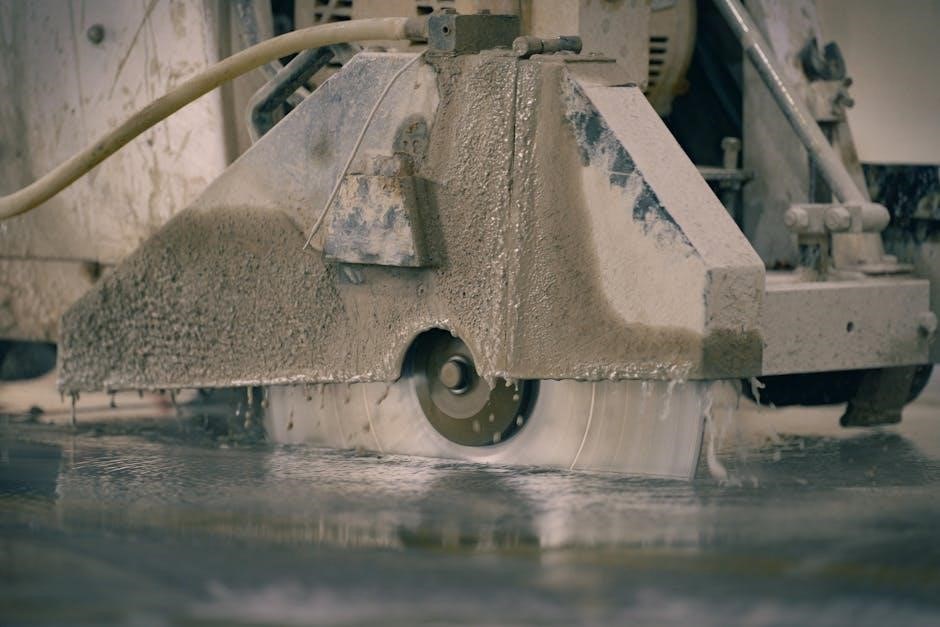
Manual surface grinding machines are versatile tools used for precision grinding of flat surfaces. They are operated manually, offering control over the grinding process. These machines are essential in workshops and industries for surface preparation, coatings removal, and polishing. Their simplicity and effectiveness make them a cornerstone in manufacturing, ensuring high-quality finishes and accurate results.
1.1 Definition and Purpose
A manual surface grinding machine is a precision tool designed for grinding flat surfaces. It operates manually, requiring operator input for controlling the grinding process. The machine uses an abrasive grinding wheel to remove material, achieving a smooth finish. Its primary purpose is for surface preparation, coatings removal, and polishing. Widely used in workshops and industries, it ensures accurate results and is essential for maintaining high-quality surface finishes in metal, concrete, and other materials.
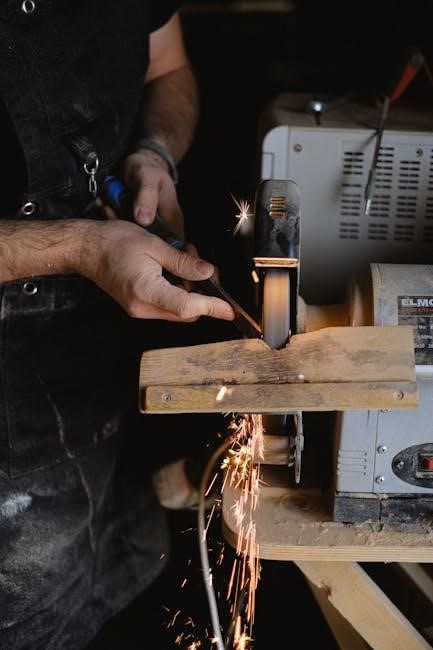
1.2 Historical Background
Manual surface grinding machines have evolved from early grinding tools. Initially used for sharpening and polishing, they were adapted for industrial use in the mid-20th century. The development of hydraulic and mechanical systems improved their efficiency. Over time, advancements in materials and design led to more precise and versatile machines. Today, they remain essential in manufacturing for surface finishing tasks. Their evolution reflects the need for precise surface preparation in various industries. These machines have become indispensable in workshops worldwide.
1.3 Importance in Modern Manufacturing
Manual surface grinding machines play a crucial role in modern manufacturing by ensuring precise surface finishes. They are essential for achieving tight tolerances and preparing surfaces for coatings or further processing. These machines are cost-effective and versatile, making them ideal for low-to-medium production volumes. Their ability to handle various materials, including metals and concrete, ensures they remain integral to workshops. Additionally, they allow for quick adjustments and flexibility, making them a valuable asset in maintaining production efficiency and quality standards across industries.
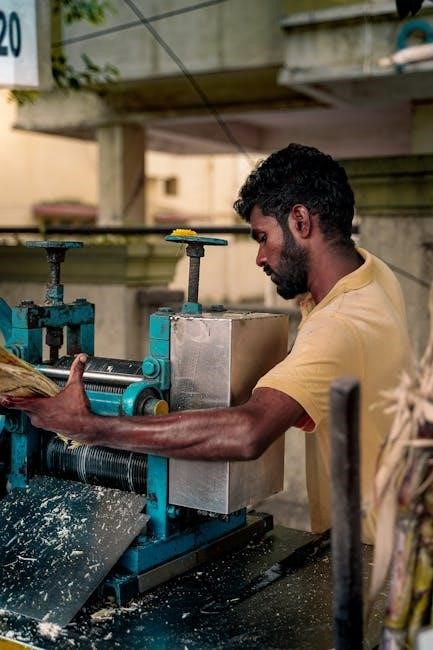
Types of Surface Grinding Machines
Surface grinding machines are categorized into horizontal, vertical, and hydraulic types, each designed for specific applications and offering unique advantages in precision and versatility.
2.1 Horizontal Surface Grinding Machines
Horizontal surface grinding machines are widely used for processing large, flat surfaces. They feature a horizontally mounted grinding wheel, ideal for grinding metal plates and flat components. These machines are known for their versatility and precision, often used in workshops for manual operations. The table moves reciprocally under the grinding wheel, ensuring consistent surface finishing. Their robust design and ease of operation make them a popular choice for various industrial applications requiring high-quality surface grinding.
2.2 Vertical Surface Grinding Machines
Vertical surface grinding machines feature a spindle mounted vertically, ideal for grinding complex shapes and intricate surfaces. These machines excel in precision grinding of dies, molds, and other components requiring detailed work. The vertical orientation allows for efficient handling of uneven surfaces, making them suitable for specialized tasks. They often utilize coolant systems to maintain material integrity and prevent overheating during the grinding process. This type is favored for its ability to achieve high accuracy in demanding industrial applications.
2.3 Hydraulic Surface Grinding Machines
Hydraulic surface grinding machines utilize hydraulic systems for precise control over grinding operations. These machines offer smooth, consistent feed rates, reducing vibration and enhancing surface finish quality. Hydraulic systems enable effortless handling of heavy-duty grinding tasks, making them ideal for large-scale industrial applications. They are known for their durability and low maintenance requirements, ensuring continuous operation in demanding environments. This type is particularly suited for grinding large, complex components where precision and power are essential. Their robust design ensures reliability and longevity in manufacturing workflows.
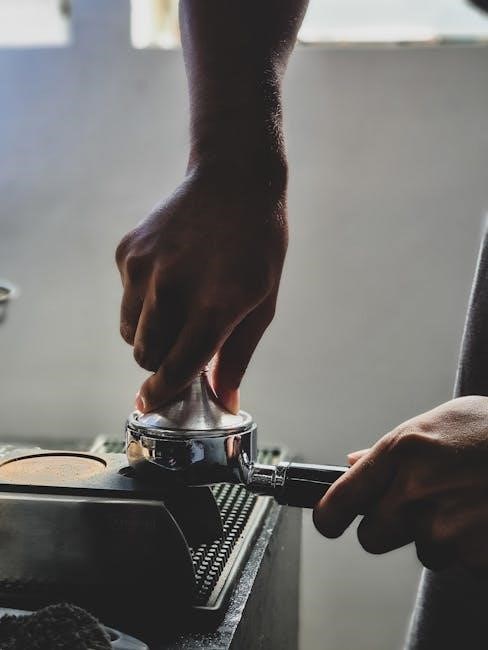
Applications of Manual Surface Grinding Machines
Manual surface grinding machines are used for surface preparation, coatings removal, and polishing concrete. They ensure smooth finishes and precise results across various industrial applications.
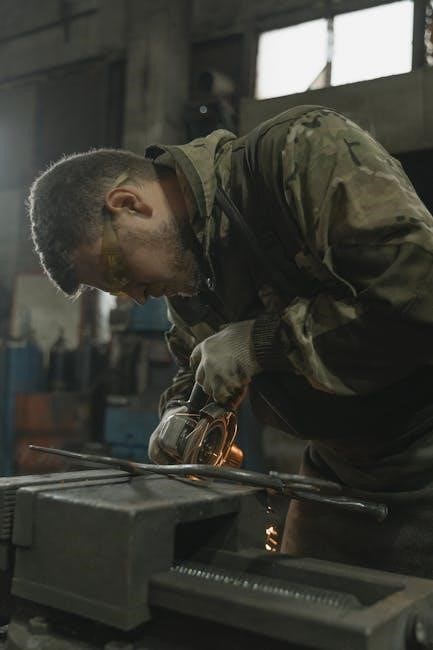
3.1 Surface Preparation
Manual surface grinding machines are essential for surface preparation, ensuring surfaces are smooth and even. They remove imperfections like rust, old coatings, and uneven textures, preparing surfaces for further treatments such as painting or coating. This process is crucial in metalworking, construction, and manufacturing, where a flawless base is necessary for durability and aesthetics. The machines’ precision allows for consistent results, making them indispensable in industries requiring high-quality surface finishes.
3.2 Coatings Removal
Manual surface grinding machines are widely used for coatings removal, effectively stripping old paint, rust, and other layers from metal surfaces. This process is crucial for refurbishment projects, ensuring surfaces are clean and ready for new coatings. The machines’ abrasive wheels, such as diamond or carbide types, efficiently remove tough materials without damaging the base surface. Proper technique is essential to avoid excessive wear and maintain surface integrity. Coatings removal is a key application, highlighting the machine’s versatility in industrial and construction settings.
3.3 Polishing Concrete
Manual surface grinding machines play a significant role in polishing concrete floors, enhancing their appearance and durability. Equipped with diamond-tipped grinding wheels, these machines effectively remove imperfections, leaving a smooth, high-luster finish. The process involves progressively finer grits to achieve the desired sheen. Polishing concrete not only improves aesthetics but also increases resistance to stains and wear. This application is particularly popular in commercial and residential settings where sleek, modern flooring is desired. Manual machines provide precise control, making them ideal for detailed concrete polishing tasks.
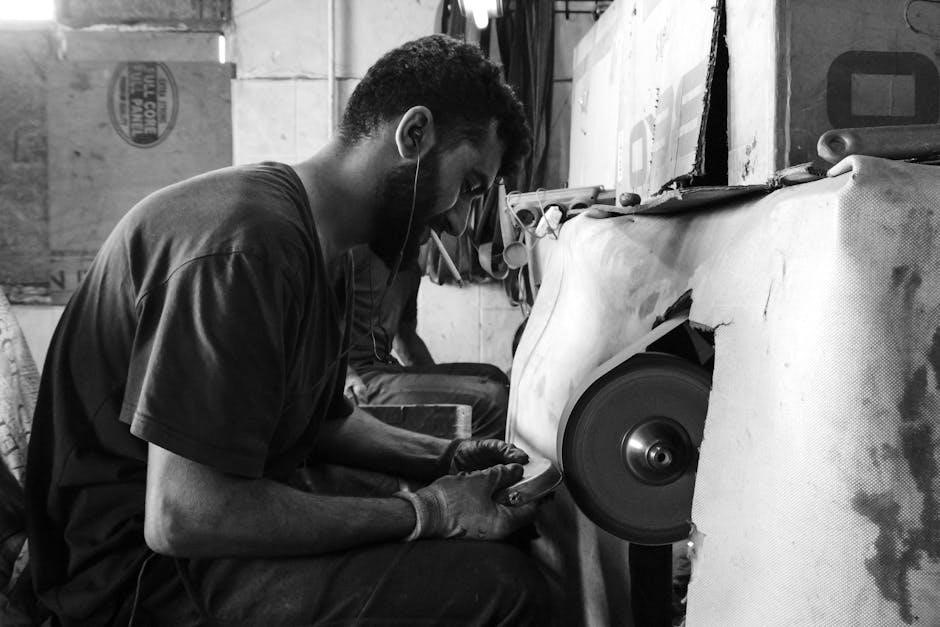
Working Principle of Manual Surface Grinding Machines
Manual surface grinding machines operate by rotating a grinding wheel against the workpiece. The spindle holds the wheel, while the table moves the material.
4.1 Basic Mechanism
The basic mechanism of manual surface grinding machines involves a grinding wheel mounted on a spindle. As the wheel rotates, the operator manually moves the workpiece across the table. The spindle ensures precise rotation, while the table’s movement controls the material’s positioning. This setup allows for accurate grinding, ensuring flat surfaces and precise dimensions. The simplicity of this mechanism makes manual machines ideal for small-scale operations and precise control. Regular maintenance, like cleaning the spindle and wheel, ensures optimal performance and longevity.
4.2 Grinding Wheel and Spindle
The grinding wheel and spindle are critical components of manual surface grinding machines. The spindle securely holds the grinding wheel, ensuring precise rotation. Grinding wheels are made from materials like diamond or silicon carbide, tailored for specific tasks. Regular cleaning of the spindle and wheel adapter is essential for maintaining accuracy. The spindle’s design allows for smooth operation, enabling consistent material removal. Proper alignment and balance of the wheel on the spindle are vital for achieving high-quality finishes and preventing vibrations during grinding operations.
4.3 Table and Feed Mechanism
The table and feed mechanism are essential for precise material handling in manual surface grinding machines. The table provides a stable platform for workpiece placement and movement. The feed mechanism, often manual, allows for controlled longitudinal or cross feed, enabling consistent grinding; Rigidity and accuracy of the table are critical for maintaining flatness and preventing deflection. Proper alignment and adjustment of the feed mechanism ensure even material removal, making it vital for achieving desired surface finishes. Regular maintenance of these components is crucial for optimal performance.
Key Components and Parts
Manual surface grinding machines consist of essential components like the grinding wheel, spindle, motor, table, and control panel. These parts work together to enable precise grinding operations.
5.1 Grinding Wheel
The grinding wheel is a critical component, consisting of abrasive grains bonded together. It determines the machine’s cutting efficiency and surface finish quality. Proper wheel selection is vital for specific materials.
Regular maintenance, such as cleaning every six months, ensures optimal performance. The wheel must be stored correctly to prevent damage. Its condition directly impacts grinding accuracy and effectiveness.
5.2 Spindle and Motor
The spindle and motor are essential for driving the grinding wheel, ensuring precise rotation and power transmission. The spindle is designed for high-speed operation, maintaining accuracy and balance. Motors vary in power, with common voltages like 380V, suiting different machine sizes. Regular spindle cleaning every six months prevents dust buildup. Proper lubrication is crucial for smooth operation and longevity. A well-maintained spindle and motor ensure consistent performance and prevent mechanical failure during grinding tasks.
5.3 Table and Cross Feed
The table and cross feed mechanism enable precise movement of the workpiece under the grinding wheel. The table ensures stable positioning, while the cross feed allows lateral movement. This setup facilitates even grinding across the surface. Manual operation grants control over feed rates, crucial for achieving desired finishes. Proper alignment and lubrication of these components are essential for smooth operation and consistent results. Regular maintenance prevents wear and ensures optimal performance in surface grinding tasks.
5.4 Control Panel
The control panel on a manual surface grinding machine serves as the central interface for operating the device. It typically features switches for starting and stopping the motor, adjusting spindle speed, and controlling the table feed. While manual machines rely on operator input, the control panel ensures precise adjustments for consistent grinding results. It may also include indicators for monitoring operational parameters. The panel’s design emphasizes simplicity and ease of use, allowing operators to focus on the grinding process without unnecessary complexity. Regular checks of the control panel ensure smooth and efficient machine operation.
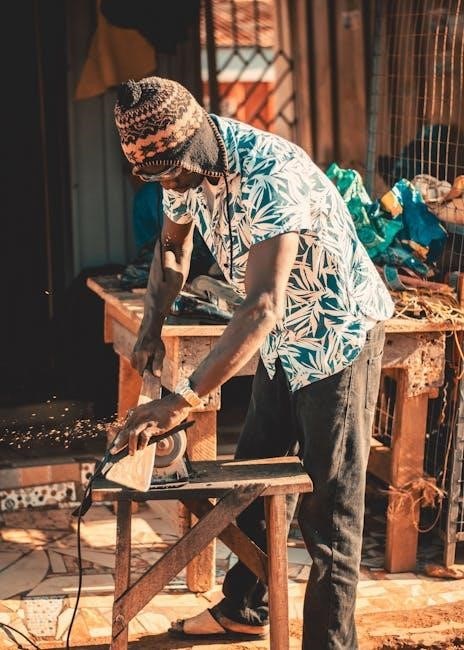
Maintenance and Repair of Manual Surface Grinding Machines
Regular maintenance ensures optimal performance of manual surface grinding machines. Daily checks, lubrication, and cleaning prevent wear. Addressing worn parts promptly extends machine longevity and efficiency.
6.1 Daily Maintenance Routines
Daily maintenance routines for manual surface grinding machines are crucial for ensuring smooth operation. Operators should check and clean the grinding wheel, spindle, and table surfaces. Lubrication of moving parts, such as the table slides and spindle bearings, must be done regularly. Additionally, inspecting the power cord and ensuring all safety guards are in place helps prevent accidents. The machine should also be cleared of dust and debris after each use to maintain accuracy and prevent damage. Consistent upkeep minimizes downtime and extends machine life, ensuring reliable performance in manufacturing processes.
6.2 Periodic Cleaning and Lubrication
Periodic cleaning and lubrication are essential for maintaining the efficiency and longevity of manual surface grinding machines; The grinding wheel should be cleaned every six months by removing it and thoroughly scrubbing the wheel adapter, spindle, and threaded components. Lubrication of moving parts, such as table slides and spindle bearings, should be performed regularly to ensure smooth operation. Inspecting for wear on components like the table and cross feed ensures optimal performance. Regular maintenance prevents dust buildup and ensures precision, while extending the machine’s lifespan.
6.3 Replacement of Wear Parts
Regular replacement of wear parts is crucial for maintaining the performance of manual surface grinding machines. Components like the grinding wheel, table, and cross feed should be inspected and replaced when worn. The grinding wheel must be replaced when it becomes uneven or loses efficiency. Lubrication points should be checked and serviced to ensure smooth operation. Replacing worn parts every 6-12 months, depending on usage, prevents damage and ensures consistent grinding results. Timely replacements enhance precision and extend the machine’s operational life.

Safety Considerations
Ensure safety by wearing PPE, securing loose clothing, and keeping workspaces clear. Establish emergency procedures and proper ventilation to prevent accidents and maintain a safe environment.
7.1 Personal Protective Equipment
Wearing appropriate PPE is crucial when operating manual surface grinding machines. Safety glasses or goggles protect eyes from debris, while a face mask prevents dust inhalation; Gloves enhance grip and prevent cuts. Hearing protection is essential due to high machine noise. Steel-toe boots and loose, tucked-in clothing minimize injury risks. Ensuring PPE is worn correctly reduces workplace accidents and enhances overall safety during grinding operations.
7.2 Workspace Preparation
Proper workspace preparation is essential for safe and efficient operation of manual surface grinding machines. Ensure the work area is clean, dry, and free from obstructions. The machine should be placed on a stable, level surface to prevent vibrations. Adequate lighting and ventilation are crucial to maintain visibility and reduce dust exposure. Keep loose clothing tied back and long hair secured. Tools and materials should be organized within easy reach to minimize distractions. A well-prepared workspace enhances productivity and safety during grinding tasks.
7.3 Emergency Procedures
In case of emergencies while operating manual surface grinding machines, immediately switch off the power and ensure the machine comes to a complete stop. If a grinding wheel breaks, evacuate the area to avoid injury from flying debris. For fires, use a fire extinguisher rated for electrical or metal fires. In case of personal injury, provide first aid and seek medical help promptly. Keep emergency contact numbers and a first-aid kit nearby. Regularly inspect the machine and ensure all safety features are functional to prevent accidents.
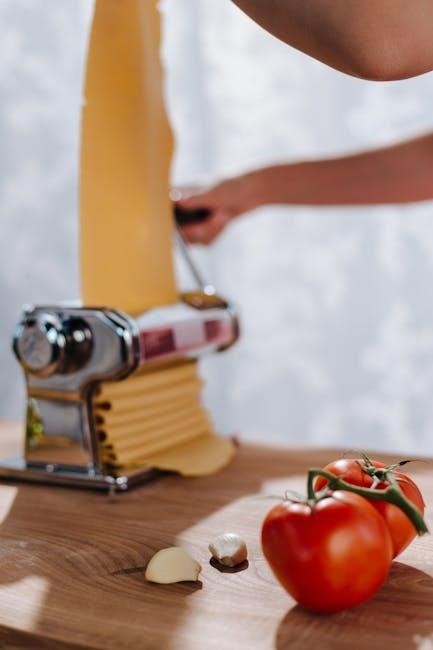
Comparison with Automatic Surface Grinding Machines
Manual surface grinding machines offer greater control and flexibility, ideal for small-scale or precise operations, while automatic machines excel in high-precision, large-scale production environments.
8.1 Advantages of Manual Machines
Manual surface grinding machines provide exceptional control, making them ideal for intricate projects requiring precision. They are cost-effective and suitable for small-scale operations. Their portability allows easy transportation between job sites. Manual machines also require less initial investment compared to automatic alternatives; Additionally, they offer flexibility, enabling operators to adapt quickly to varying tasks, such as surface preparation and coatings removal. This adaptability makes them a preferred choice for workshops with diverse grinding needs. Their simplicity ensures lower maintenance costs and ease of operation.
8.2 Limitations of Manual Machines
Manual surface grinding machines have several limitations. They are labor-intensive, requiring skilled operators for precise results. This dependency on human effort can lead to variability in output quality. Manual machines are also slower compared to automatic counterparts, making them less efficient for large-scale production. Additionally, they are less suitable for complex or high-precision tasks due to potential human error. Maintenance requirements are higher, and operator fatigue can impact performance. Despite their versatility, manual machines are best suited for small-scale applications rather than industrial mass production.
8.3 Choosing the Right Type for Your Needs
Selecting the appropriate manual surface grinding machine involves understanding your project requirements. Consider the size and complexity of the workpiece, desired precision levels, and budget constraints. Horizontal machines are ideal for flat surfaces, while vertical machines suit angled or intricate work. Automation needs and operator expertise also play a role. Assessing these factors ensures optimal performance and efficiency, helping you make an informed decision tailored to your specific applications and operational goals.
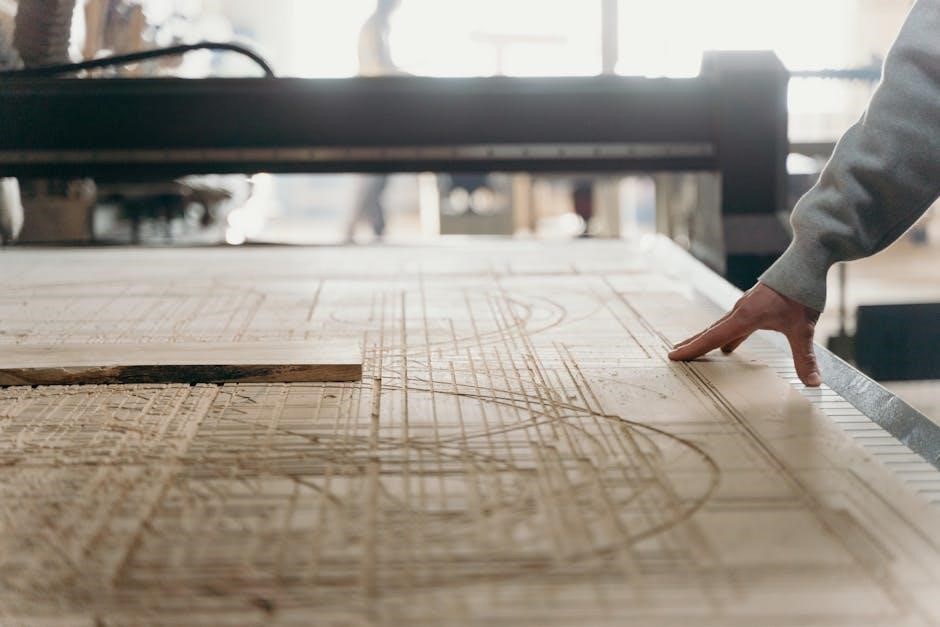
Future Trends in Manual Surface Grinding Technology
Future trends emphasize integrating advanced materials, ergonomic designs, and energy-efficient technologies to enhance performance and sustainability, ensuring manual surface grinding machines remain relevant in evolving industries.
9.1 Integration of Advanced Materials
The integration of advanced materials, such as diamond-coated grinding wheels and high-performance abrasives, is revolutionizing manual surface grinding machines. These materials enhance durability, reduce wear, and improve grinding efficiency. Innovations in wheel composition, like cubic boron nitride (CBN), offer superior heat resistance and longer lifespan. Additionally, lightweight yet robust materials are being introduced to optimize machine portability without compromising performance. Such advancements ensure manual grinding machines remain competitive, delivering precision and sustainability in modern manufacturing processes.
9.2 Improved Ergonomics and Usability
Manual surface grinding machines are being redesigned with enhanced ergonomics to reduce operator fatigue and improve usability. Adjustable handles, intuitive control panels, and optimized weight distribution are key focus areas. Manufacturers are incorporating ergonomic principles to ensure comfortable operation over extended periods. Additionally, user-friendly interfaces and clear operational guidelines are being integrated to simplify the grinding process. These improvements aim to boost productivity while ensuring operator safety and satisfaction, making manual grinding machines more accessible and efficient for modern workshops.
9.3 Environmental and Energy Efficiency
Modern manual surface grinding machines are increasingly designed with environmental and energy efficiency in mind. Advances in materials and technology have led to the use of eco-friendly grinding wheels and reduced power consumption. Manufacturers are also incorporating features like dust collection systems and energy-efficient motors to minimize environmental impact. Additionally, the development of quieter machines and sustainable cooling methods aligns with global efforts to reduce industrial carbon footprints. These improvements not only benefit the environment but also contribute to cost savings for industries adopting these machines.
Manual surface grinding machines remain essential tools in modern manufacturing, offering precision and versatility for various applications. Their adaptability, cost-effectiveness, and ease of use make them indispensable for surface preparation, coatings removal, and polishing. Despite advancements in automation, manual machines continue to be preferred for low-precision tasks and smaller-scale operations. With ongoing innovations in environmental and energy efficiency, these machines are likely to remain relevant, providing reliable solutions for industries seeking high-quality finishes and durability. Their enduring utility underscores their importance in both traditional and evolving manufacturing processes.